
The Solar Trade Association (STA) and Renewable Energy Association (REA) have both expressed their disappointment over the government’s watering down of carbon targets for new properties in the 2013 Building Regulations following the government’s decision to introduce only minimal increases to carbon targets. The targets are even lower even than the relatively weak proposals contained in the original consultation.
The STA wanted to see a convincing step towards reaching ‘Zero Carbon’ standards in 2016, but the Department for Communities and Local Government (DCLG) has instead announced carbon reduction standards of just 6 percent for domestic properties and 9 percent for non-domestic properties, relative to 2010 levels, lower than the levels consulted on. In addition, according to the STA, the data used by the DCLG to model the cost of on-site renewables is out of date.
New properties, particularly those built by volume house builders, can achieve major cost economies for solar PV and solar thermal and can also be designed with roof orientation to optimise solar performance. This would enable homeowners occupying properties with solar thermal and solar PV to enjoy considerable protection from high energy bills. Given that new build is excluded from the Renewable Heat Incentive (RHI) with the exception of self-build properties, Building Regulations are particularly important for building a vibrant green heating industry.
“It's depressing to see so little leadership from central Government in transforming how we build homes in the UK” said STA Chief Executive Paul Barwell. “It is hard to see how such modest improvements in building energy performance will get us to full Zero Carbon standards in 2016 – just three years away.Given the current volatility of energy bills, homeowners are ill-served by policies that fail to drive established renewable heat and power generation technologies in new homes. Neither can we see how such modest Part L changes will help the construction industry to develop the skills it needs to build genuinely low or zero carbon homes.”
The weak improvements follow systemic watering-down of new build standards by the government including the dilution of what is actually meant by the term ‘Zero Carbon Home’. It has also cancelled a planned increase in environmental standards for new social housing and sought to extend ‘allowable solutions’ as a way of outsourcing a property’s emissions. The Part L announcements have also been delayed by six months.
“This is a failure of ambition which seriously undermines the Government’s intention to fully implement Zero Carbon standards in 2016” added REA Head of Policy Paul Thompson. “This is a real missed opportunity, as it is often much cheaper to install renewable technologies during construction rather than retrofit. DCLG’s strong focus on reducing costs is also undermined by its reliance on out-of-date cost data for solar PV.”
DCLG is expected to launch a new consultation on the Allowable Solutions and the Housing Standards Review which will consider the ability of local authorities to set their own standards for emissions from new buildings. The STA wants to see support for local authorities wanting higher standards, meanwhile the Scottish Government has developed a series of clear standards, from Bronze through to Platinum, which is 100 percent Zero Carbon.
“The self-congratulatory tone of the DCLG press release can't disguise the derisory nature of this change to efficiency standards” said Chair of the STA Solar Thermal Working Group, Stuart Elmes. “This baby-step towards Zero Carbon serves the construction industry ill and leaves it with all to do in 2016. Central Government appears to lack the will to drive forward the agenda in low carbon building.The STA calls on local authorities around England and Wales to pick up the baton and use their powers to set higher performance standards and encourage the construction industry to develop the skills and techniques that will be needed to deliver energy efficient new homes and buildings.”
Further information:

